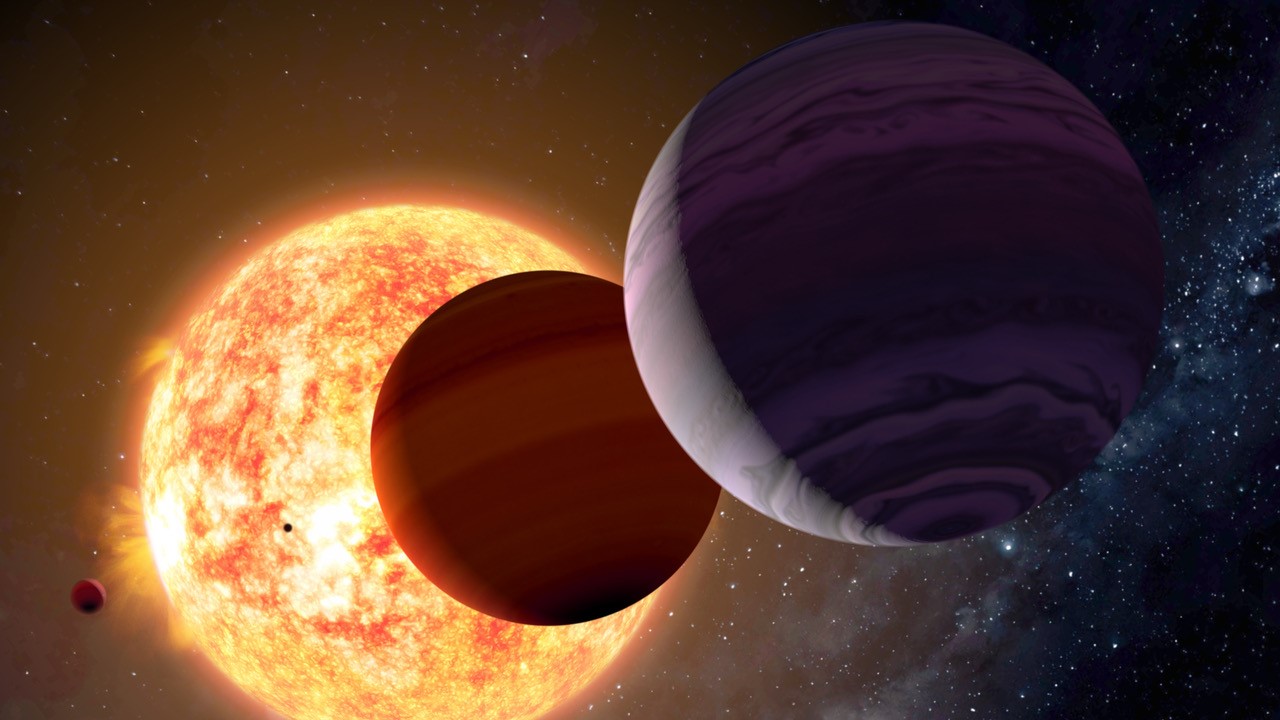Giant planets could reach maturity sooner than expected
The Institute of Astrophysics of Andalusia (IAA-CSIC) participates in the study of the giant planets of the V1298 Tau system, which in just twenty million years have already reached their final size. The finding has been possible thanks to radial velocity measurements from the HARPS-N spectrographs, at the Roque de los Muchachos Observatory (ORM), and from CARMENES, at the Calar Alto Observatory (CAHA)
Current theories of planetary evolution predict that giant planets, such as Jupiter or Saturn, are born with large dimensions and very low densities and that, after hundreds of millions of years of slow contraction, they reach their final size. However, these expectations do not have corroborating evidence, and a recent finding shows that they may not correspond to reality in some cases. An international scientific team has measured the mass of the planets of the V1298 Tau system, one of the youngest known, and concludes that the giant planets could complete their contraction much faster than expected. The result is published in the journal Nature Astronomy.
"The characterization of very young planets is extraordinarily difficult: their stars present very high levels of activity and until very recently it was unthinkable to even try it," says Alejandro Suárez Mascareño, a researcher at the Instituto de Astrofísica de Canarias (IAC) who is leading the investigation. Only thanks to the combination of detections with space telescopes, combined with intense radial velocity campaigns and the use of the most advanced analysis techniques, is it possible to begin to see what is happening at such early stages in the evolution of planetary systems".
With an estimated age of twenty million years, V1298 Tau is one of the youngest known solar-type stars that has a planetary system that produces transits (or mini eclipses produced when the planets, as they rotate around the star, hide part of its light). V1298 Tau is home to a multiple system made up of two planets the size of Neptune, one the size of Saturn and one the size of Jupiter.

The work published today reveals the presence of two periodic signals compatible with the orbits of two of its planets. On the one hand, planet b, which revolves around the star every 24 days, has a mass of 0.64 Jupiter masses and a density similar to the giant planets of the Solar System. On the other, planet e, which ends its orbit in 40 days, shows a mass of 1.16 Jupiter masses and a density greater than most giant exoplanets.
“These are unexpected dimensions for such young planets, and the work suggests that some giant planets could evolve faster than anticipated. Our knowledge is changing towards the idea that the planets would begin to form in much earlier stages of the joint evolution with the star -indicates Pedro J. Amado, a researcher at the Institute of Astrophysics of Andalusia (IAA-CSIC) who participates in the finding-. We are currently in a sweet moment, being able to connect the studies of planets in very young but already formed stars, such as V1298 Tau, with that of even younger systems and still with protoplanetary disks and planets in formation".
The study of young systems provides clues about what happened during the infancy of our Solar System, and helps to build a more solid idea of the early evolution of planetary systems. For example, if it is verified that V1298 Tau is a normal case, and that its evolution is similar to that of most planets, it would be necessary to rethink the history of formation of the giant planets of the Solar System.
It has been necessary to combine radial velocity measurements from various instruments such as the HARPS-N spectrograph, installed at the Telescopio Nazionale Galileo (TNG) of the Roque de los Muchachos Observatory, or the high-resolution CARMENES spectrograph, at the Calar Alto Observatory, among others.
"Once again, the added value that CARMENES has on the international scene in modern astrophysics, especially in exoplanetary sciences, is highlighted. The observations made with the 3.5-meter telescope with this instrument have been decisive and more than necessary to studying this very interesting object. It is a clear example of synergies that positions the Calar Alto Observatory at the forefront", points out Jesús Aceituno, director of the Calar Alto Observatory and co-author of the study.
The Istituto Nazionale di Astrofisica (INAF, Italy), the Astrobiology Center (CAB, CSIC), the Andalusian Institute of Astrophysics (IAA, CSIC), the Leibniz-Institute for Astrophysics (Germany) or the National Institute for Astrophysics, Optics and Electronics participated in the work, led by the Instituto de Astrofísica de Canarias (IAC).
A. Suárez Mascareño et al. "Rapid contraction of giant planets orbiting the 20 million-years old star V1298 Tau". Nature Astronomy https://www.nature.com/articles/s41550-021-01533-7
Instituto de Astrofísica de Andalucía (IAA-CSIC)
Unidad de Divulgación y Comunicación
Silbia López de Lacalle - sll[arroba]iaa.es - 958230676
https://www.iaa.csic.es
https://divulgacion.iaa.csic.es

